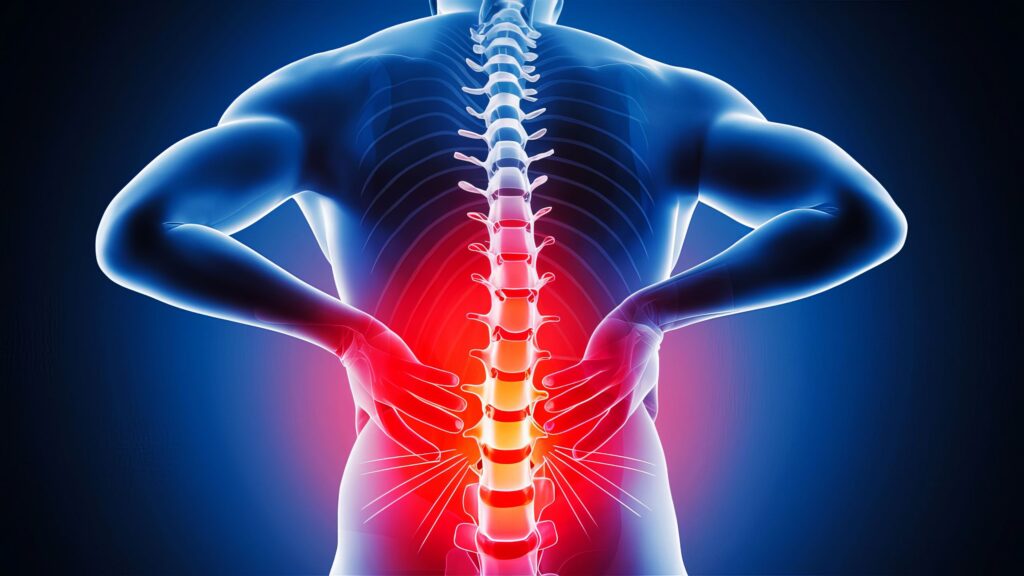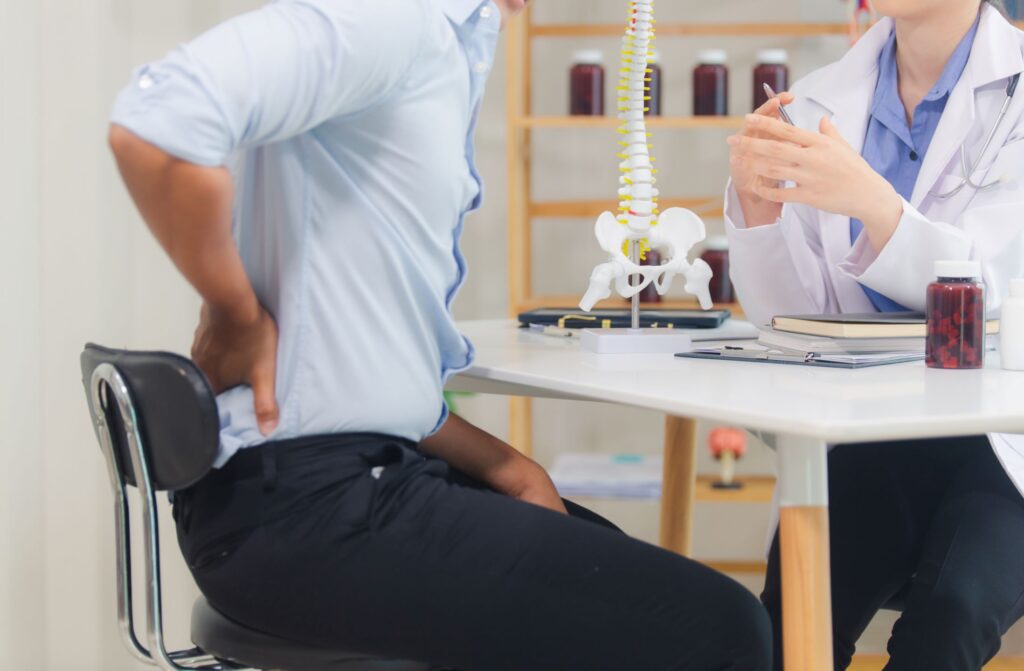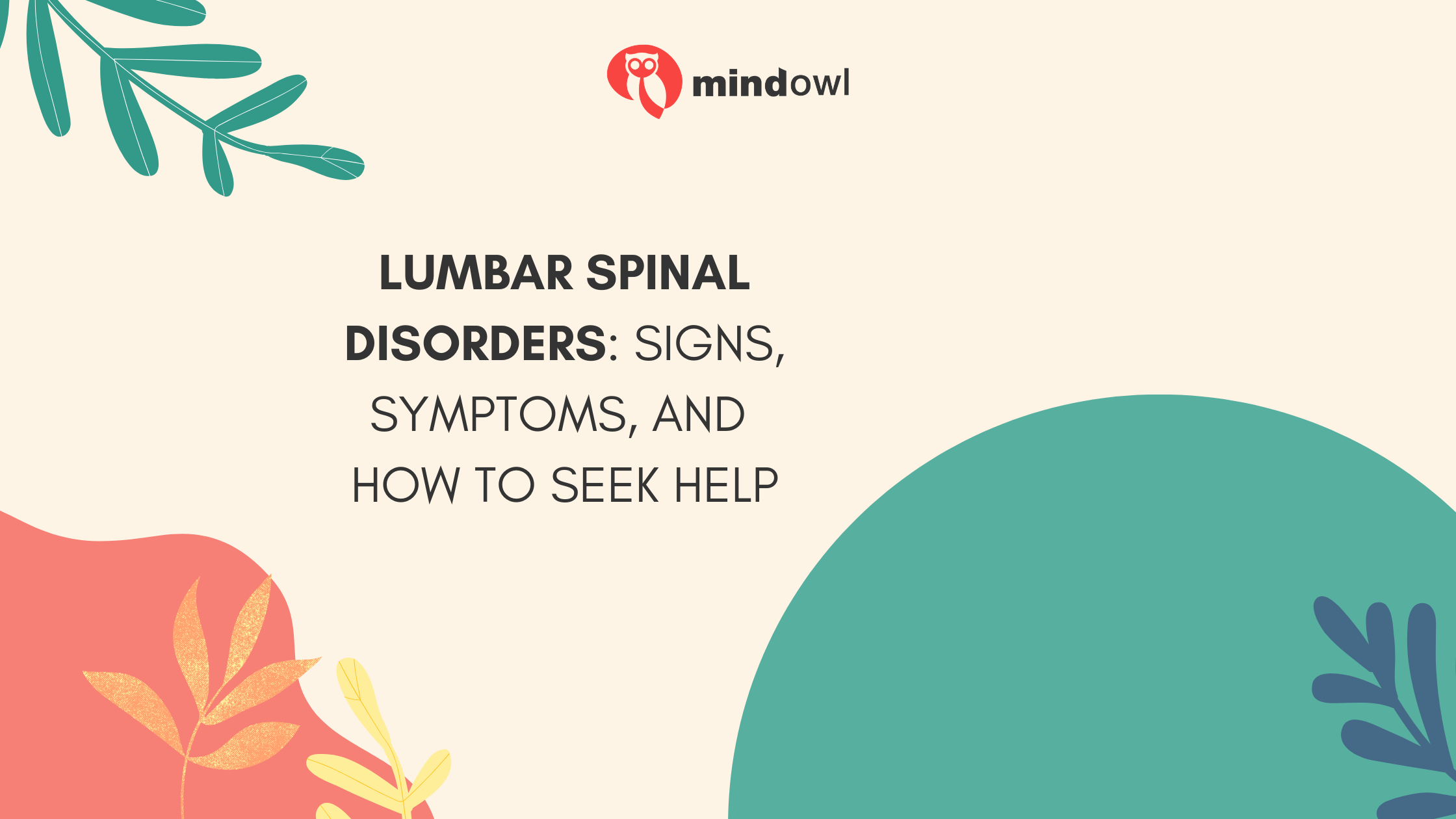The lumbar spine, located in the lower back, plays a crucial role in supporting the upper body’s weight and facilitating movement. Given its significant function, this region is susceptible to various disorders that can impact daily activities and overall quality of life. Hence, understanding the signs and symptoms of lumbar spinal disorders is essential for timely intervention and effective management.
Read on to learn the signs, symptoms, and how to seek help.

Common Lumbar Spinal Disorders
Several conditions can affect the lumbar spine, each presenting unique challenges. Some common lumbar spinal disorders include:
Lumbar Spinal Stenosis
This condition involves the narrowing of the spinal canal in the lower back, leading to nerve compression. Some symptoms include:
- Lower back pain
- Burning sensations radiating to the buttocks and legs (sciatica)
- Numbness, tingling, or cramping in the legs
- Weakness in the lower limbs
- Loss of sensation in the feet
- In severe cases, loss of bowel or bladder control
Herniated Lumbar Disc
Also known as lumbar disc disease, this occurs when the intervertebral disc’s inner material protrudes through its outer layer, pressing on nearby nerves. Symptoms include:
- Intermittent or continuous back pain
- Sciatica (pain radiating down the leg)
- Muscle spasms and weakness in the legs
- Numbness in the legs or feet
- Decreased reflexes at the knee or ankle
- Possible changes in bladder or bowel function
Degenerative Disc Disease
With aging, the intervertebral discs can lose hydration and elasticity, leading to disc degeneration. This can result in the following:
- Chronic lower back pain
- Reduced spinal flexibility
- Radiating pain or weakness in the legs due to nerve compression
Spondylolisthesis
This condition occurs when one vertebra slips forward over another due to degenerative changes or stress fractures. Some common symptoms include:
- Persistent lower back pain
- Stiffness and reduced mobility
- Radiating nerve pain or numbness in the legs if nerve compression occurs
Axial Spondyloarthritis (AxSpA)
AxSpA is a chronic inflammatory arthritis affecting the spine and sacroiliac joints. Some symptoms often include:
- Chronic lower back pain and stiffness, especially in the morning or after inactivity
- Pain that improves with exercise but worsens with rest
- Reduced spinal mobility
- Fatigue and general discomfort
Therefore, seeking specialized care for spinal conditions is critical for proper diagnosis and treatment. For those experiencing persistent lower back pain or other spinal issues, working with providers like Dickinson Neurological Surgery can be an excellent idea as they offer expert medical consultation and treatment options. Recognizing symptoms early and addressing them with a qualified specialist can significantly improve outcomes.

Recognizing the Signs and Symptoms
Since many lumbar spinal disorders share overlapping symptoms, it’s essential to recognize key indicators that warrant medical evaluation. The most common signs include:
- Persistent lower back pain lasting more than six weeks
- Radiating pain, numbness, or tingling in the legs or feet
- Difficulty walking, standing, or maintaining balance
- Weakness in the lower extremities
- Loss of bladder or bowel control (a medical emergency)
If any of these symptoms persist or worsen, seeking medical evaluation is crucial to prevent long-term complications.
Diagnosis of Lumbar Spinal Disorders
A thorough medical assessment is necessary to determine the underlying cause of lumbar spine issues. Some diagnostic approaches may include:
Physical Examination
A physical examination is the first step in diagnosing lumbar spinal disorders. It involves assessing posture, range of motion, and spinal alignment. The doctor checks for muscle weakness, abnormal reflexes, and signs of nerve compression. Simple tests like walking on heels and toes can help evaluate balance and muscle function, aiding in accurate diagnosis.
X-rays
X-rays can provide a clear image of the spinal bones, helping detect abnormalities such as fractures, spondylolisthesis (vertebral slippage), and bone spurs. They also reveal signs of disc degeneration and arthritis. While X-rays don’t show soft tissues, they’re essential for identifying structural issues contributing to pain, stiffness, or nerve compression in the lumbar spine.
Magnetic Resonance Imaging (MRI)
MRI scans can produce high-resolution images of soft tissues, including intervertebral discs, spinal nerves, and ligaments. This non-invasive imaging method can help detect herniated discs, spinal stenosis, tumors, or inflammation. Unlike X-rays or CT scans, MRIs can provide critical insights into nerve compression and disc health, making them vital for diagnosing complex lumbar spine disorders.
Computed Tomography (CT) Scan
CT scans use multiple X-ray images to create a detailed cross-sectional view of the spine. They’re particularly useful for detecting spinal stenosis, fractures, and bone abnormalities. CT myelograms, which involve injecting contrast dye, can enhance visualization of nerve roots and the spinal canal, helping doctors assess the severity of compression-related spinal conditions.
Electromyography (EMG)
EMG tests evaluate nerve function by measuring electrical activity in muscles. Small needle electrodes are inserted into muscles to detect nerve dysfunction, compression, or damage caused by conditions like herniated discs or spinal stenosis. EMG results can help differentiate between muscle and nerve disorders, guiding doctors in diagnosing and treating lumbar spinal conditions effectively.
An accurate diagnosis allows for the development of a targeted treatment plan to address the specific spinal condition.
Treatment Options for Lumbar Spinal Disorders
Treatment for lumbar spinal disorders varies depending on the severity and nature of the condition. Some options include:
Physical Therapy
Physical therapy focuses on strengthening core and back muscles to support the spine. Targeted exercises can help improve flexibility, enhance posture, and reduce strain on spinal structures, helping to alleviate pain and prevent further lumbar spine complications.
Pain Management
Pain management involves using medications like NSAIDs to reduce inflammation, muscle relaxants to ease spasms, and nerve pain medications to target neuropathic pain. These treatments can help manage discomfort and improve daily function without requiring surgery.
Epidural Steroid Injections
Epidural steroid injections deliver anti-inflammatory medication directly into the spinal canal, reducing nerve swelling and pain. These injections can provide temporary relief for conditions like herniated discs and spinal stenosis, allowing patients to engage in rehabilitation effectively.
Lifestyle Modifications
Maintaining a healthy weight, practicing proper posture, and using ergonomic furniture can reduce spinal strain. Lifestyle changes can also help prevent worsening lumbar disorders, improve spinal alignment, and decrease pain by minimizing stress on vertebrae and surrounding structures.
Laminectomy
A laminectomy involves removing a portion of the vertebral bone (lamina) to create more space for compressed nerves. This procedure can help relieve symptoms of spinal stenosis, improving mobility and reducing pain caused by nerve pressure.
Discectomy
A discectomy is performed to remove a portion of a herniated disc that’s pressing on spinal nerves. This procedure alleviates nerve compression, reduces pain, and restores function, particularly in patients with sciatica or nerve-related discomfort.
Spinal Fusion
Spinal fusion involves permanently connecting two or more vertebrae using bone grafts and hardware. This procedure can stabilize the spine, reduce painful motion, and is often recommended for severe degenerative disc disease or spinal instability.
Artificial Disc Replacement
Artificial disc replacement substitutes a damaged intervertebral disc with a prosthetic one. This procedure maintains spinal flexibility, preserves motion, and alleviates pain, making it a suitable alternative to spinal fusion for select patients.
Preventing Lumbar Spine Issues
While some lumbar spinal disorders result from aging or genetic predisposition, proactive steps can help reduce the risk of developing these conditions. Preventive measures include:
Maintaining Proper Posture
Proper posture reduces spinal strain and prevents long-term damage. Keeping the spine aligned while sitting, standing, or lifting can help distribute weight evenly. When lifting heavy objects, bending at the knees rather than the waist can minimize stress on the lumbar spine, reducing the risk of injury and chronic pain.
Regular Exercise
Engaging in regular exercise strengthens core and back muscles, providing crucial support to the lumbar spine. Activities like yoga improve flexibility, swimming can help reduce joint stress while enhancing endurance, and strength training builds spinal stability. These exercises can also help prevent injuries, alleviate tension, and promote proper posture. By maintaining an active lifestyle, one can reduce the risk of degenerative spinal conditions, ensuring long-term spinal health and overall well-being.
Healthy Weight Management
Excess weight places additional pressure on the lower back, increasing the risk of spinal disorders. Maintaining a healthy weight through balanced nutrition and exercise can help reduce strain on intervertebral discs, preventing degeneration and chronic pain. A well-balanced diet combined with an active lifestyle can also promote spinal health and overall well-being.
Avoiding Prolonged Sitting
Sitting for extended periods increases pressure on the lumbar spine, leading to stiffness and discomfort. Taking regular breaks to stand, walk, or stretch improves circulation and relieves tension. Adjusting desk ergonomics and incorporating movement throughout the day can also help maintain spinal alignment and prevent long-term complications associated with sedentary habits.
When to Seek Medical Help
Ignoring persistent back pain can lead to worsening symptoms and long-term complications. Immediate medical attention is necessary if the following situations occur:
- Back pain is accompanied by numbness, tingling, or weakness in the legs
- Pain worsens despite rest and conservative treatments
- There’s a loss of bladder or bowel control
- Difficulty walking or maintaining balance occurs
Consulting a neurological specialist ensures timely diagnosis and access to appropriate treatment options.
Conclusion
Lumbar spinal disorders can significantly impact daily life, making early detection and proper treatment essential. Understanding the various conditions, recognizing symptoms, and seeking professional medical care can help individuals manage pain and maintain spinal health. Addressing spinal issues proactively ensures better long-term outcomes and improved quality of life.
MindOwl Founder – My own struggles in life have led me to this path of understanding the human condition. I graduated with a bachelor’s degree in philosophy before completing a master’s degree in psychology at Regent’s University London. I then completed a postgraduate diploma in philosophical counselling before being trained in ACT (Acceptance and commitment therapy).
I’ve spent the last eight years studying the encounter of meditative practices with modern psychology.

